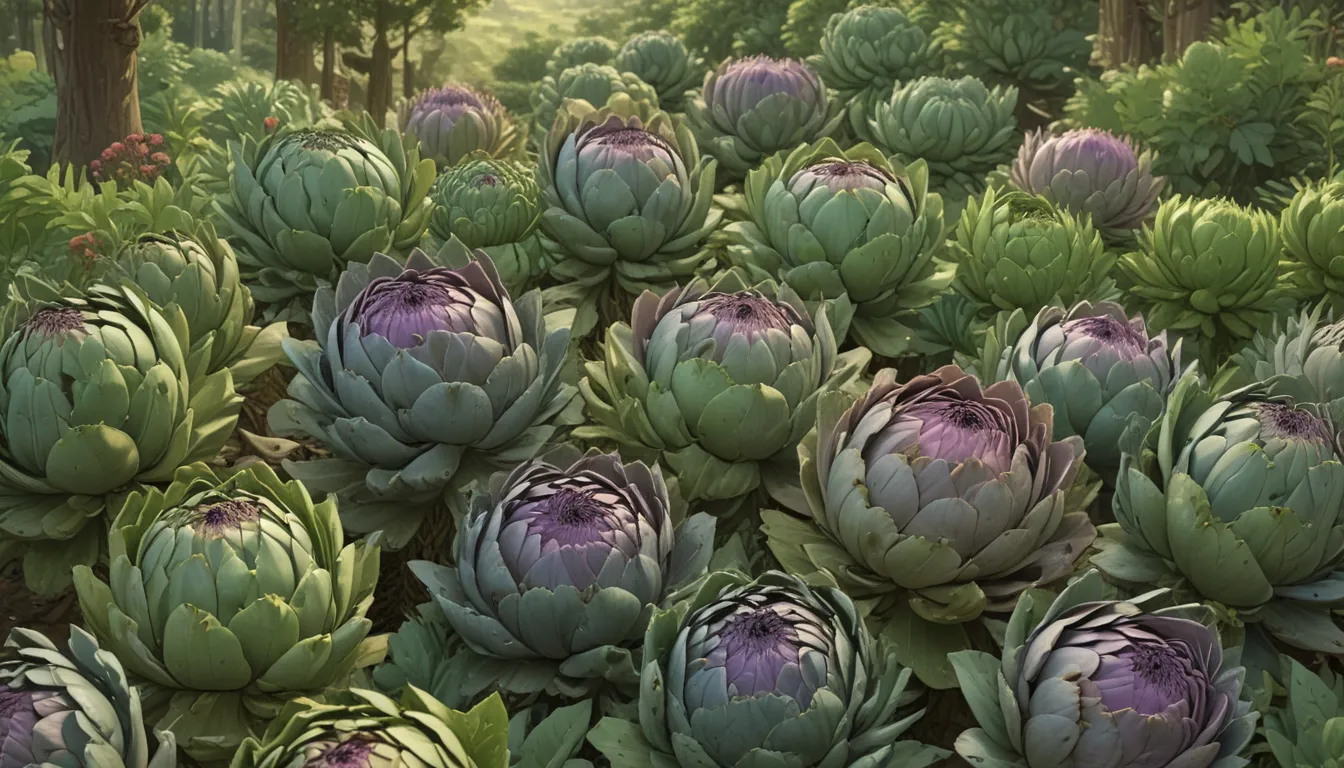Ultimate Guide to Growing Artichokes at Home

Are you a fan of artichokes? Why not try growing your own fresh supply at home? These ornamental plants can not only serve as a beautiful addition to your garden or yard but also provide you with delectable artichokes for your culinary delights. Even if you have a shorter growing season, with the right planning and selection of cultivars, you can successfully grow these Mediterranean vegetables in your garden.
In this comprehensive guide, we will cover everything you need to know about planting and growing artichokes, along with valuable tips and tricks to ensure a successful harvest. So let’s dive in!
What You’ll Learn
- Cultivation and History
- Propagation
- How to Grow
- Growing Tips
- Maintenance
- Cultivars to Select
- Managing Pests and Disease
- Harvesting
- Storing and Preserving
- Recipes and Cooking Ideas
- Quick Reference Growing Guide
Before we embark on this exciting journey of growing artichokes, let’s ensure we are all on the same page. This article specifically focuses on Cynara cardunculus var. scolymus, commonly known as “globe artichokes.” It is essential to distinguish this variety from tubers such as “sunchokes” or “Jerusalem artichokes,” which belong to a different botanical classification (Helianthus tuberosus).
Cultivation and History
Artichokes may not be the most common garden vegetable, but they are highly adaptable to various climates and growing conditions. Native to Mediterranean regions, artichokes are perennial plants that thrive in USDA Hardiness Zones 7 to 10. However, gardeners in colder zones can still grow them as annuals with proper protection.
Did you know that artichokes are actually thistles? They share a resemblance with thistles and are botanically related to various plants like Cosmos, Dandelion, and Marigold.
The history of artichokes dates back to ancient Greece and the Roman Empire. Introduced to Europe from Northern Africa, they became a prized vegetable over time. Interestingly, the word “artichoke” traces its roots back to the Arabic term “al-karsufa,” highlighting the vegetable’s diverse historical journey across cultures.
A Note of Caution:
Artichokes can become weedy in certain conditions, with naturalized populations in California and Arizona. If you live in a similar climate, consider growing them in containers to prevent their invasive spread.
Artichoke plants have striking ornamental foliage with large, toothed leaves that form rosettes. The edible part of the plant is the flower bud, known as the head, which should be harvested before flowering for the best taste and texture. Additionally, artichokes have notable health benefits, including antioxidant properties and high fiber content.
Propagation
Artichokes are propagated either by seed or division. When preparing your garden beds, ensure a sunny location with fertile, well-draining soil. Starting artichokes from seeds or transplants requires attention to the growing season’s length and temperature requirements.
From Seed
You can grow artichokes from seeds by direct sowing or starting them indoors. Choose a method based on your growing season’s length and follow proper seed starting procedures for successful germination.
From Transplants
Transplanting artichokes requires careful consideration of vernalization needs for optimal bud production. Plan your planting dates to allow young plants exposure to cold temperatures for budding in their second growing season.
From Division
Dividing mature artichoke plants to propagate new ones is a simple method to increase your crop. Performing divisions in spring, when new growth is visible, ensures successful establishment of new plants.
How to Grow
Providing ideal growing conditions for artichokes is essential for a bountiful harvest. Focus on the following factors to support healthy plant growth:
- Climate: Artichokes prefer cool-season conditions and require vernalization for bud formation.
- Sun: Plant in full sun or partial shade, especially in hot climates.
- Water: Consistent watering, deep but infrequent, supports robust plant growth.
- Soil: Artichokes adapt well to various soil types but thrive in rich, well-draining soil.
- Companion Planting: Cilantro, cosmos, and dill attract beneficial insects to control pests.
Growing Tips
- Plant in full sun or partial shade
- Grow in rich, well-draining soil
- Provide regular water and water deeply
Maintenance
Artichokes require regular maintenance to thrive and produce healthy buds. Mulching, weeding, fertilizing, and pruning are essential tasks to ensure productive plants. Here are some maintenance tips for successful artichoke cultivation:
Mulching
Apply mulch around young plants to conserve moisture, regulate soil temperature, and suppress weed growth. Mulching also protects roots and prevents evaporation of soil moisture.
Weeding
Regular weeding prevents competition for water, sunlight, and soil nutrients. Remove weeds to reduce stress on young plants and ensure optimal growth conditions.
Fertilizer
Based on soil test results, apply composted manure or balanced fertilizer monthly during the growing season to support plant growth. Adjust fertilization rates based on specific soil nutrient requirements.
Staking
In windy climates, stake artichoke plants to provide additional support and prevent damage from strong winds. Secure the stalks to stakes with twine to maintain plant stability.
Pruning
Prune plants after the first harvest to encourage a second crop in the same season. Remove spent stems and buds to promote new growth and maximize yield potential.
Overwintering Care
In cold climates, protect artichoke plants from freezing temperatures by mulching heavily and covering crowns with soil. Alternatively, dig up roots and store them indoors for winter protection.
Cultivars to Select
Choose artichoke cultivars suitable for your climate and growing conditions to ensure successful plant development. Popular varieties like “Green Globe” offer excellent taste, size, and production characteristics.
When selecting cultivars, be mindful of your climate and vernalization requirements to optimize harvest outcomes. Experiment with different varieties to find the best fit for your garden and culinary preferences.
Managing Pests and Disease
Artichokes are susceptible to various pests and diseases, including aphids, plume moths, and powdery mildew. Implement integrated pest management strategies to control infestations and protect plants from damage.
Insects
Monitor plants for common pests like aphids, plume moths, and flea beetles. Implement cultural and biological control measures to reduce populations and prevent damage to crops.
Disease
Prevent diseases like artichoke curly dwarf virus, damping off, and powdery mildew by practicing proper plant care and sanitation. Remove diseased plant material promptly to prevent further spread of pathogens.
Harvesting
Harvest artichokes at the optimal stage when bracts begin to open but are still tight. Use a sharp knife to cut buds with a portion of the stem attached to ensure freshness. Harvest side shoots for baby artichokes and main buds for larger heads.
Plan your harvests based on cultivar maturity and climate conditions to maximize yield and flavor. Store fresh artichokes in the refrigerator for short-term storage or freeze for long-term preservation.
Storing and Preserving
To extend the shelf life of artichokes, store them in the refrigerator for up to two weeks. Alternatively, freeze or dehydrate artichokes for extended storage and use in recipes. Preserve artichoke hearts in oil with proper acidification for safe consumption.
Experiment with different preservation methods to enjoy artichokes year-round and elevate your culinary creations with homegrown produce.
Recipes and Cooking Ideas
Explore a diverse range of recipes and cooking ideas to savor the unique flavor of artichokes. From steamed artichokes with vinaigrette to grilled baby artichokes and savory quiches, there are countless ways to enjoy this versatile vegetable.
Try different cooking techniques and flavor combinations to create delicious dishes that showcase the natural taste and texture of artichokes. Incorporate artichokes into salads, pizzas, pastas, and appetizers for a gourmet dining experience at home.
Incorporate garden-fresh artichokes into your culinary repertoire and elevate your home cooking with seasonal produce. Share your favorite artichoke recipes and cooking tips with fellow gardeners to exchange ideas and inspire culinary creativity.
Conclusion
Growing artichokes at home is a rewarding experience that allows you to enjoy fresh, flavorful produce straight from your garden. By following best practices for planting, cultivating, and maintaining artichoke plants, you can achieve a successful harvest and savor the fruits of your labor.
Experiment with different cultivars, growing techniques, and preservation methods to discover the best approach for your gardening style and culinary preferences. Share your artichoke growing journey with others to inspire a community of home gardeners dedicated to sustainable food production and culinary excellence.
Embrace the art of growing artichokes and experience the joy of cultivating a unique, edible plant in your garden. From planting seeds to harvesting buds, every step of the process offers valuable lessons and opportunities for creativity in the kitchen.
For more gardening guides, recipes, and expert tips, visit our website for a wealth of information on growing, cooking, and preserving a wide variety of fruits, vegetables, and herbs. Join our community of passionate gardeners and food enthusiasts to explore the world of homegrown produce and culinary delights. Happy gardening and happy cooking!





